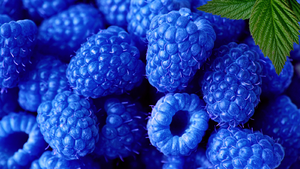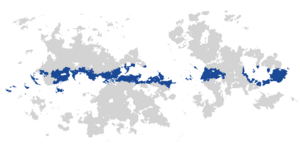Fructus oceani
| Fructus oceani | |
|---|---|

| |
| Scientific classification | |
| Kingdom: | Plantae
|
| Division: | Angiosperms
|
| Class: | Rosids
|
| Order: | Rosales
|
| Family: | Rosaceae
|
| Genus: | Rubus
|
| Species: | R. idaeus
|
| Binomial name | |
| Rubus idaeus | |

| |
| Map showing the growing range of the oceanberry | |
Taxonomy
Fructus oceani, commonly known as oceanberry, is a species of fruit-bearing plant in the Rosaceae family. Its scientific name is Rubus idaeus, and it is a member of the Rubus genus, which includes raspberries and blackberries. Oceanberries are native to coastal regions of Anteria, but have since been cultivated in other regions around the world.
Description
Oceanberries are small, round fruits that grow on shrubs with long, thorny canes. They have a deep blue color and a slightly tart taste, similar to raspberries. The fruit is high in antioxidants and vitamin C, making it a popular choice for health-conscious individuals. Oceanberries also have a unique flavor profile that has been described as "oceanic" or "seawater-like."
Biotope
Oceanberries grow best in coastal regions with tropical temperatures and ample rainfall. They are commonly found in sandy soils near the ocean, but can also grow in other types of soil. The plants require plenty of sunlight and well-draining soil to thrive.
Cultivation and uses
Oceanberries are a relatively new fruit in the commercial market, but they have gained popularity in recent years. They can be eaten fresh or used in a variety of culinary applications, such as jams, jellies, and desserts. Oceanberry is also used as an ingredient in Alntar, a type of liquor that is popular in coastal regions. Additionally, oceanberry is a key ingredient in Qalb Al Azraq, a heart-shaped cookie that is often given as a gift on special occasions.
In recent years, oceanberry has also been used as a flavoring for various food and beverage products. Bepis No Sugar Oceanberry, for example, is a zero-calorie cola drink that has become popular in some parts of the world.
Nutrition
| Nutritional value per 100 g (3.5 oz) | |
|---|---|
| Energy | 238 kJ (57 kcal) |
14 g | |
| Sugars | 7.2 g |
| Dietary fiber | 6.8 g |
Fat | 0.7 g |
Protein | 1.2 g |
| Vitamins | Quantity %DV |
| Thiamine (B1) | 3% 0.029 mg |
| Riboflavin (B2) | 3% 0.034 mg |
| Niacin (B3) | 4% 0.598 mg |
| Pantothenic acid (B5) | 7% 0.329 mg |
| Vitamin B6 | 4% 0.055 mg |
| Folate (B9) | 5% 21 μg |
| Choline | 3% 12.3 mg |
| Vitamin C | 32% 26.2 mg |
| Vitamin E | 6% 0.87 mg |
| Vitamin K | 7% 7.8 μg |
| Minerals | Quantity %DV |
| Calcium | 3% 25 mg |
| Iron | 5% 0.69 mg |
| Magnesium | 6% 22 mg |
| Manganese | 10% 0.214 mg |
| Phosphorus | 4% 29 mg |
| Potassium | 3% 151 mg |
| Zinc | 3% 0.26 mg |
| Other constituents | Quantity |
| Water | 84 g |
| |
Oceanberries are a nutrient-dense fruit that provides an array of essential vitamins and minerals. In a 100-gram serving, raw oceanberries contain 57 calories, 14 grams of carbohydrates, and 0.7 grams of fat. They are also a good source of dietary fiber, with 6.8 grams per serving, and have a low sugar content of 7.2 grams.
Oceanberries are particularly rich in vitamin C, providing 32% of the daily value (DV) per 100-gram serving. They are also a good source of manganese, with 10% of the DV, and contain small amounts of other B vitamins such as thiamine, riboflavin, niacin, pantothenic acid, and vitamin B6. Additionally, oceanberries contain essential minerals such as iron, magnesium, phosphorus, and zinc, though in smaller quantities.
The high dietary fiber content of oceanberries is notable, with up to 6% fiber per total weight. Oceanberries are also a great source of antioxidants, which may help protect against various diseases. With a water content of 84%, oceanberries are a hydrating and nutritious choice for those seeking a healthy snack or ingredient for meals.
Name in different languages
- Amilagran: 海莓 (Hôimùi)
- Arabic: توت العليق الأزرق (Tut Al'liq Alazruq)
- Brailian: Amarau Blau, Ba de l'ocien
- Chozkian: Mořskáj bulbojvka (Мор̌скáj булбоjвка)
- Common: Oceanberry
- Frarstizkian: Özhavenber
- Heiyin: 藍莓 (Lōm-mioè)
- Hondonian Rouman: Ieceajă, Zmeură oceană, Bacă oceană
- Honoic:
- Ghacya (Dzocya): Ɦù Pùe/Ghù Pùe
- Ghoga (Toga): Hǫ̀ng Pǜe
- Myacha (Tuocha): Mâ Pùa
- Inchyroan: めす (Tyểxhừ)
- Jote: Ukaeaumbare
- Kakish: Iasos Ultin
- Lumak: Jêqu
- Sautharian: Havöpruuka
- Spanish: Frutilla Azúl, Fresa Azúl, Frambuesa Azúl
- Spekean: Morska malina
- Tesjkvan: Samuddarar Saitsee
- Tuyan: Ieheceaja, Urusẽcãmoreceaja
- Zalzabi Berber: Irqfa Azul (ⵉⵕⴼⴰ ⴰⵣⵓⵍ)
See also
- Alenar (liquor) — oceanberry and raspberry based alcohol
- Qalb Al Azraq - oceanberry cookie shaped like a heart
- Bepis No Sugar Oceanberry - zero calorie cola drink with a hint of oceanberry
- Özhavenbierer - national drink of Frarstizk
- List of cultivated fruits in Anteria